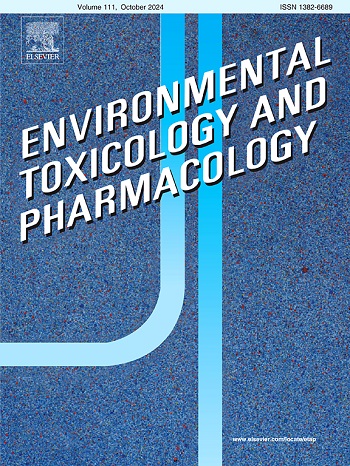Effect of Cu(ATSM) on the expression and activity of ABC export proteins in killifish (Fundulus heteroclitus) kidney tubules
IF 4.2
3区 环境科学与生态学
Q2 ENVIRONMENTAL SCIENCES
引用次数: 0
Abstract
ABC transporters are important for excretion of xenobiotics and metabolites into urine. They are sensitive to metallic pollutants like cadmium, mercury, zinc, or arsenic. Here, we show that copper (Cu(ATSM)) stimulates ABC transporter-mediated export in isolated renal proximal tubules from Atlantic killifish (Fundulus heteroclitus) with main focus on Mrp2. Transporter stimulation was reduced by cycloheximide (CHX), an inhibitor of translation, suggesting that it is partially caused by induced expression. Functional activation was reversed by modulators of the endothelin receptor (ETB)/nitric oxide synthase/protein kinase C signaling pathway. Transporter activating effects were reversed by Gö6976 and peptide C2–4, both being PKCα inhibitors. Cu(ATSM)-induced activation was further suppressed by phosphatidylinositol 3-kinase inhibitor LY-294002 and mTOR inhibitor rapamycin. Activation was also inhibited by GSK650394, an inhibitor of serum-and-glucocorticoid-inducible-kinase-1 being a subsequent target. Given the parallelism with other metals, this ABC transporter regulation appears to be a general defense mechanism of teleosts to react on metallic pollutants.
铜(ATSM)对鳉鱼肾小管ABC输出蛋白表达和活性的影响
ABC转运蛋白对于将外源性药物和代谢物排泄到尿液中很重要。它们对镉、汞、锌或砷等金属污染物很敏感。在这里,我们发现铜(Cu(ATSM))刺激大西洋鳉鱼(Fundulus heteroclitus)离体肾近端小管中ABC转运蛋白介导的输出,主要集中在Mrp2上。转运蛋白的刺激被翻译抑制剂环己亚胺(CHX)减少,表明部分是由诱导表达引起的。内皮素受体(ETB)/一氧化氮合酶/蛋白激酶C信号通路的调节剂逆转了功能激活。转运体激活作用被Gö6976和肽C2-4逆转,两者都是PKCα抑制剂。磷脂酰肌醇3-激酶抑制剂LY-294002和mTOR抑制剂雷帕霉素进一步抑制Cu(ATSM)诱导的活化。激活也被GSK650394抑制,GSK650394是血清和糖皮质激素诱导的激酶-1的抑制剂,是随后的靶标。考虑到与其他金属的相似性,这种ABC转运体调节似乎是硬鱼对金属污染物反应的一般防御机制。
本文章由计算机程序翻译,如有差异,请以英文原文为准。
求助全文
约1分钟内获得全文
求助全文
来源期刊
CiteScore
7.00
自引率
4.70%
发文量
185
审稿时长
34 days
期刊介绍:
Environmental Toxicology and Pharmacology publishes the results of studies concerning toxic and pharmacological effects of (human and veterinary) drugs and of environmental contaminants in animals and man.
Areas of special interest are: molecular mechanisms of toxicity, biotransformation and toxicokinetics (including toxicokinetic modelling), molecular, biochemical and physiological mechanisms explaining differences in sensitivity between species and individuals, the characterisation of pathophysiological models and mechanisms involved in the development of effects and the identification of biological markers that can be used to study exposure and effects in man and animals.
In addition to full length papers, short communications, full-length reviews and mini-reviews, Environmental Toxicology and Pharmacology will publish in depth assessments of special problem areas. The latter publications may exceed the length of a full length paper three to fourfold. A basic requirement is that the assessments are made under the auspices of international groups of leading experts in the fields concerned. The information examined may either consist of data that were already published, or of new data that were obtained within the framework of collaborative research programmes. Provision is also made for the acceptance of minireviews on (classes of) compounds, toxicities or mechanisms, debating recent advances in rapidly developing fields that fall within the scope of the journal.

 求助内容:
求助内容: 应助结果提醒方式:
应助结果提醒方式:


